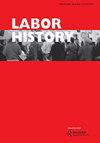Unitarians and revolutionaries. The trade unionism of the MC and the LCR in CCOO
IF 0.7
4区 管理学
Q1 HISTORY
引用次数: 0
Abstract
ABSTRACT This article aims to analyse the trade union trajectory of the Movimiento Comunista (MC) and of the Liga Comunista Revolucionaria (LCR) within the Comisiones Obreras (CCOO), the main workers’ organisation during the Transition. Both, the MC and the RCL actively participated in its construction, seeing the CCOO as the materialisation of the workers’ United Front (FU). Both organisations maintained relations within the CCOO for many years. These relations went through moments of collaboration and sympathy, moments of distancing and later moments of stable alliance against the Partido Comunista de España (PCE) inside of CCOO. From this alliance came the Izquierda Sindical (IS), a trade union platform which for many years brought together trade unionists from the two organisations until its absolute dissolution at the end of 1991. The history of their trade union intervention can help to better understand the history of these organisations, which are still in the process of being re-discovered by the academy.统一派和革命者。MCO的工会主义与CCOO中的LCR
摘要本文旨在分析过渡时期主要工人组织奥布雷拉委员会(CCOO)内的工会运动(MC)和革命联盟(LCR)的工会轨迹。MC和RCL都积极参与其建设,将CCOO视为工人统一战线(FU)的具体化。这两个组织在CCOO内部保持了多年的关系。这些关系经历了合作和同情的时刻,疏远的时刻,以及后来在CCOO内部与西班牙共产党(PCE)稳定结盟的时刻。这个联盟产生了Izquierda Sindic(IS),这是一个工会平台,多年来一直将这两个组织的工会成员聚集在一起,直到1991年底完全解散。他们工会干预的历史有助于更好地了解这些组织的历史,这些组织仍在被学院重新发现的过程中。
本文章由计算机程序翻译,如有差异,请以英文原文为准。
求助全文
约1分钟内获得全文
求助全文
来源期刊

Labor History
Multiple-
CiteScore
1.00
自引率
28.60%
发文量
44
期刊介绍:
Labor History is the pre-eminent journal for historical scholarship on labor. It is thoroughly ecumenical in its approach and showcases the work of labor historians, industrial relations scholars, labor economists, political scientists, sociologists, social movement theorists, business scholars and all others who write about labor issues. Labor History is also committed to geographical and chronological breadth. It publishes work on labor in the US and all other areas of the world. It is concerned with questions of labor in every time period, from the eighteenth century to contemporary events. Labor History provides a forum for all labor scholars, thus helping to bind together a large but fragmented area of study. By embracing all disciplines, time frames and locales, Labor History is the flagship journal of the entire field. All research articles published in the journal have undergone rigorous peer review, based on initial editor screening and refereeing by at least two anonymous referees.
 求助内容:
求助内容: 应助结果提醒方式:
应助结果提醒方式:


